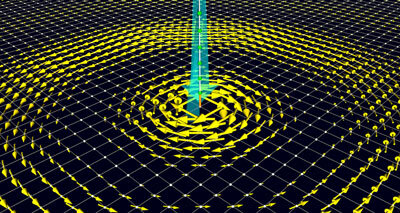2D Materials and Interfaces Capable of Transforming Spin Current into a Vortex of Charge Current
Energy-efficient spintronic devices are closer to being realized thanks to a new mechanism predicted by RIKEN physicists for converting between electrical current vortices and a spin current.
In addition to possessing a negative electrical charge, an electron exhibits spin, which can be either up or down. Similar to how the charge of an electron is utilized for information processing in electronics, spin could play a role in the emerging field of spintronics. Unlike electrical current, a spin current in spintronics is more energy-efficient, as it does not generate Joule heat.
The development of an efficient mechanism to convert electronic current into a spin current and vice versa is essential for advancing spintronic devices. Through numerical simulations, Sadamichi Maekawa and Seiji Yunoki, along with their colleagues from the RIKEN Center for Emergent Matter Science, have successfully showcased the conversion of a spin current into a rotating vortex of charge current. This achievement leverages the Rashba effect, an unusual phenomenon discovered in 1959, which occurs at surfaces or interfaces between materials where the atomic structure lacks symmetry.

The Rashba effect facilitates the interaction between an electron’s spin and orbital motion. Maekawa explains that spin-orbit coupling, a relativistic effect that mixes the spin and orbital motion of electrons, is crucial for spintronics and is particularly important in oxide interface structures and certain two-dimensional materials, generating novel topological phenomena beneficial for spintronics. Using large-scale computer simulations, Maekawa and his team modeled the injection of a spin current into a Rashba material via a point-sized electrical contact.
The simulations indicated that this arrangement, with the spins’ direction perpendicular to the Rashba material, produced a rotating flow of charge current. This outcome stems from the conservation of angular momentum, where the junction predominantly converts the injected spin angular momentum into the orbital angular momentum of the current vortex. Maekawa emphasizes the significance of the dynamics of electrons in electronics, encompassing both diffusive flow and hydrodynamic or turbulent motion. While spintronics has traditionally focused on the diffusive flow of electrons, this research introduces the possibility of hydrodynamic spintronics, expanding the field to include the hydrodynamic regime of electrons.
This article is republished from PhysORG under a Creative Commons license. Read the original article.
Do not forget to share your opinion with us to provide you with the best posts !



0 Comments